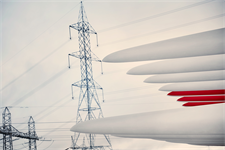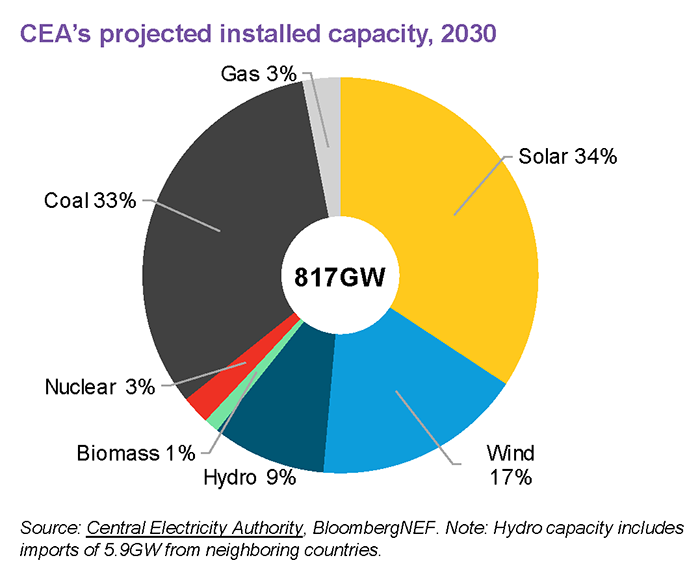Offshore industry urged to act fast and switch to cost saving 132kV array systems
Energy Disrupter
Doubling the voltage of offshore wind farm array systems – from 66kV to 132kV – will be critical to enabling the use of larger turbines and help the global industry successfully scale up to 250GW installed capacity by 2030, while saving significant costs, suggests a Carbon Trust report on the Offshore Wind Accelerator (OWA) Programme’s high-voltage array systems (Hi-VAS) project.
To avoid suboptimal future wind farm designs, industry needs to act as a matter of urgency to make the transition to 132kV operating voltage, it adds.
The Hi-VAS project considered the nominal voltages of 90kV, 110kV, 132kV and 150kV as candidates for a new higher voltage array standard across a range of different turbine sizes (14MW, 17MW and 20MW) and several offshore wind farm sizes and configurations common in industry. The report, “Unlocking the next generation of offshore wind: step change to 132kV array systems”, says technical, economic, regulatory and risk assessments, in conjunction with consensus from the supply chain industry, clearly indicate that the 132kV operating voltage is the “cost-optimal” choice for a future-proof array system.
Using 132kV systems offers significant cost savings over 66kV, it says, even for wind turbines of 14MW, which are currently available at 66kV. A 1.2GW wind farm using 132kV cables, for example, could save £32-50 million (€37-50 million), relative to the equivalent 66kV system, it suggests.
The industry’s last voltage shift, from 33kV to 66kV, began in 2010 and was considered a key factor in offshore wind’s success, enabling 8-12MW turbines to be installed.
The report says the next jump to 132kV will enable more efficient power collection for future wind farms globally, reduce the length of cables in offshore wind farms – resulting in lower costs and environmental footprints – and facilitate the next generation of offshore wind turbines.
The research found that 132kV array systems are technically feasible – “uncovering no technical showstoppers” – and have the best benefit-to-cost ratio of the voltages studied, driven primarily by cheaper cables and wind turbine switchgear compared to 150kV.
It notes that 132kV is also a standard power distribution and transmission voltage and aligns with existing equipment standards that will facilitate international supply chain buy-in.
Equipment and accessories are either in development or already available from a range of suppliers and are expected to be competitively priced due to economies of scale.
Time to market for 132kV SF6 free compact switchgear is much quicker than for 150kV as commercial products already exist, while time to market for 132kV array cable and accessories would also be much quicker than for 150kV, as several manufacturers have ongoing research and development into 132kV technologies.
The actual cost savings that can be achieved “directly relate to cable technology”. Maximum savings are shown for wet cable designs — cables that do not have an impermeable barrier and allow the water to migrate into the cable insulation and conductor. These are cheaper, lower loss and have higher current carrying capacity.
Dry type cables — designed to prevent water ingress — also remain cost beneficial against 66kV for all turbine sizes. The report also notes that cost savings improve with increasing turbine rating.
Overall, array life cycle cost savings could be as high as 35% for 132kV arrays compared with the 66kV base case under the most favourable conditions (20MW turbines, 132kV wet cables), the report says. Even under the least favourable conditions (14MW turbine, 132kV dry cable), the minimum cost savings are still in excess of 20%.

Source: The Carbon Trust
If the life cycle cost of the transmission system is added to the array life cycle cost, then the electrical life cycle cost savings resulting from 132kV arrays are between 3.6% and 6.9% relative to the 66kV base case, it adds.
Urgency
Currently, however, the earliest a 132kV wind farm could be operational is the end of the 2020s, “even with immediate proactive work” from developers and the supply chain, it says. “To ensure the most efficient voltage level is used for future offshore wind farms, it is critical no time is lost. The industry must focus on 132kV technology development to ensure the dramatic cost savings that 132kV will bring are realised as soon as possible,” the report says.
The report includes a roadmap to help accelerate the transition. Urgent measures required include:
• defining robust requirements and standards for 132kV cables,
• development, qualification and testing of 132kV cables,
• understanding the implications of 132kV on floating wind, and
• developing improved cable connectors and testing methods.
The Hi-VAS project partners were the Carbon Trust, EnBW, Equinor, Ocean Winds, Ørsted, RWE, ScottishPower Renewables, Shell, SSE Renewables, TotalEnergies and Vattenfall, with TNEI and Petrofac delivering the project.









 – Tips For Waste And Recycling For Shops
– Tips For Waste And Recycling For Shops





